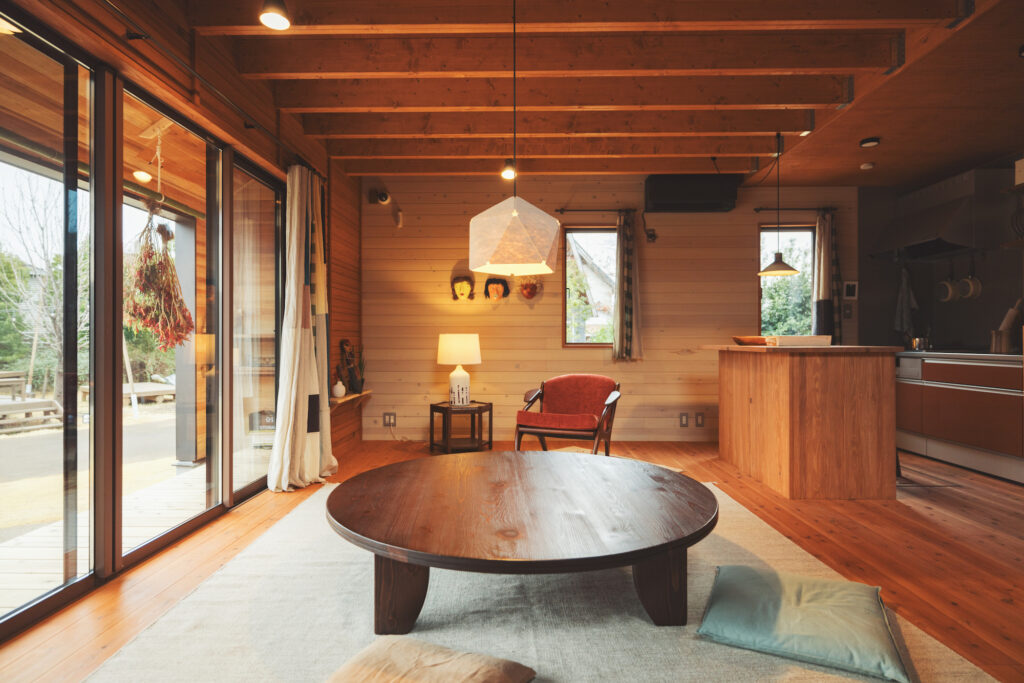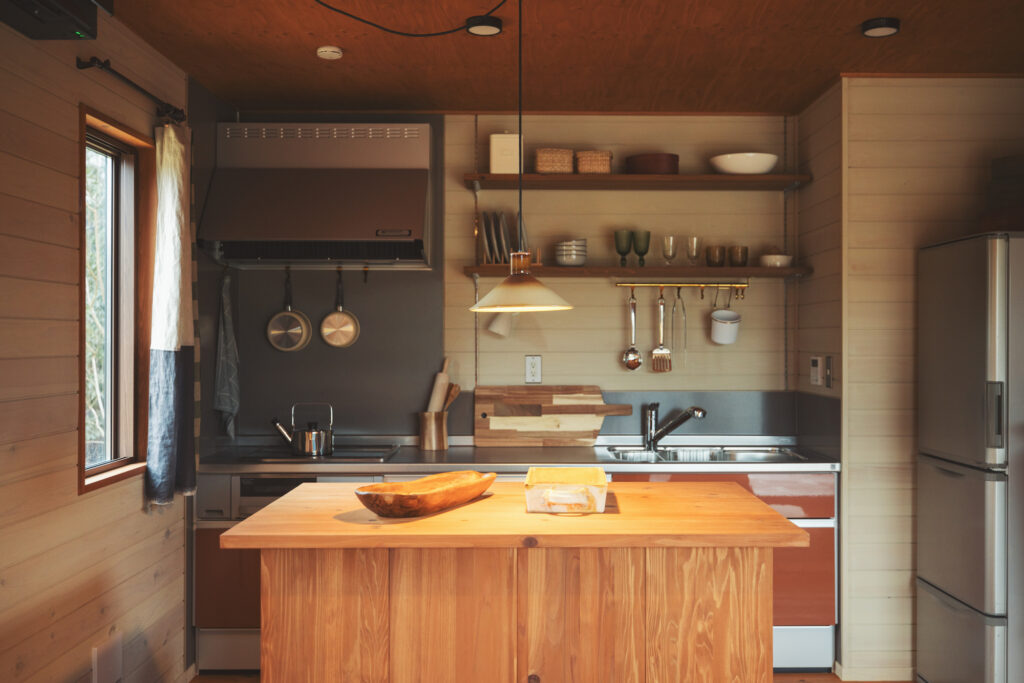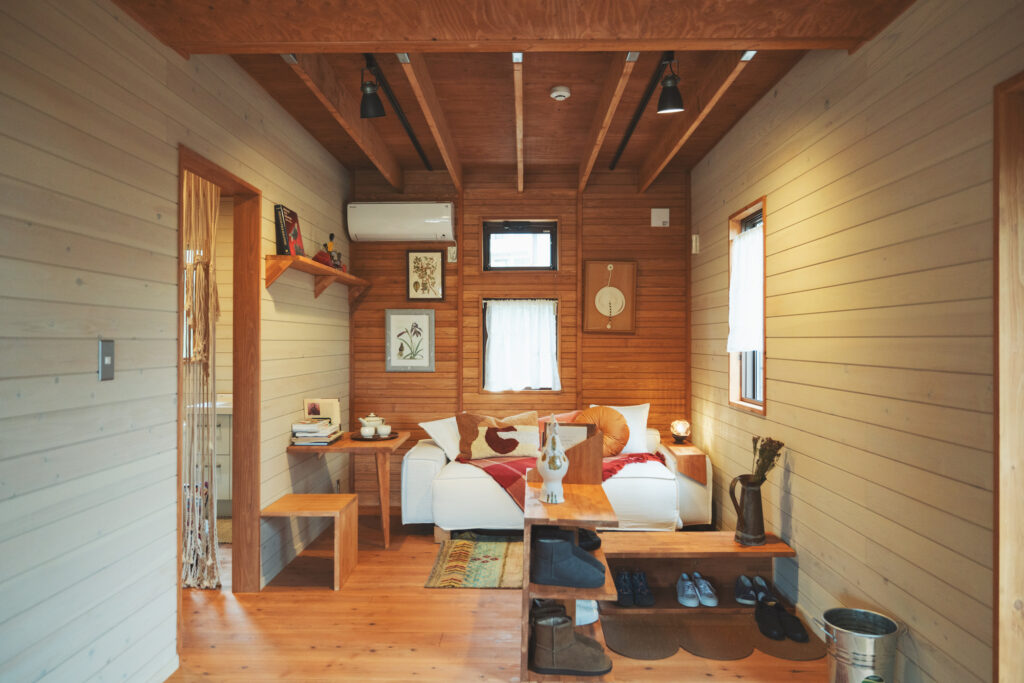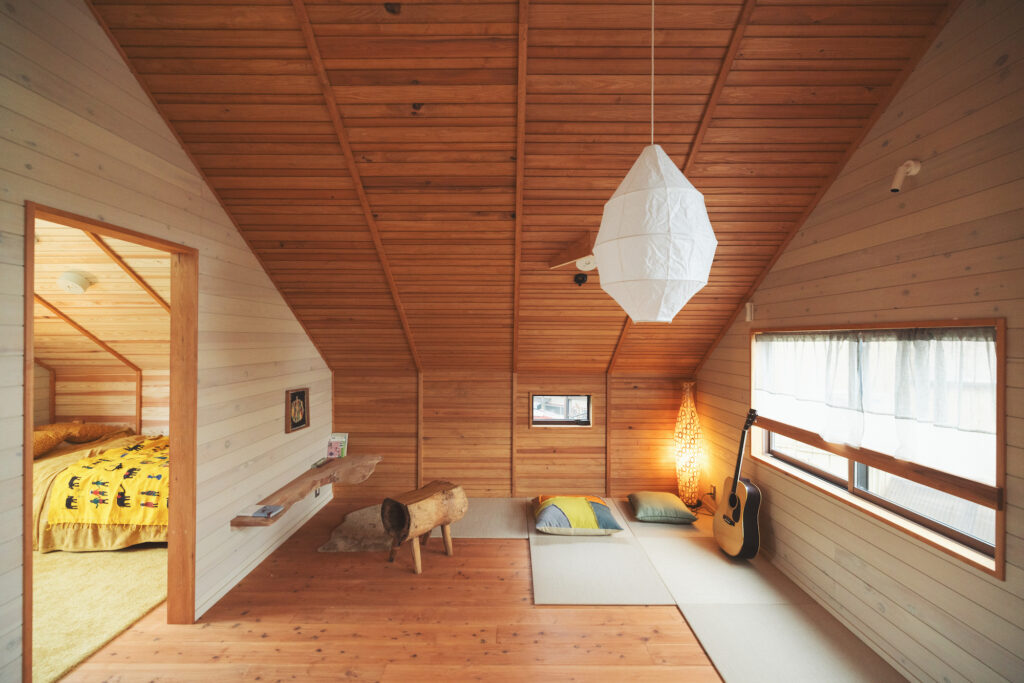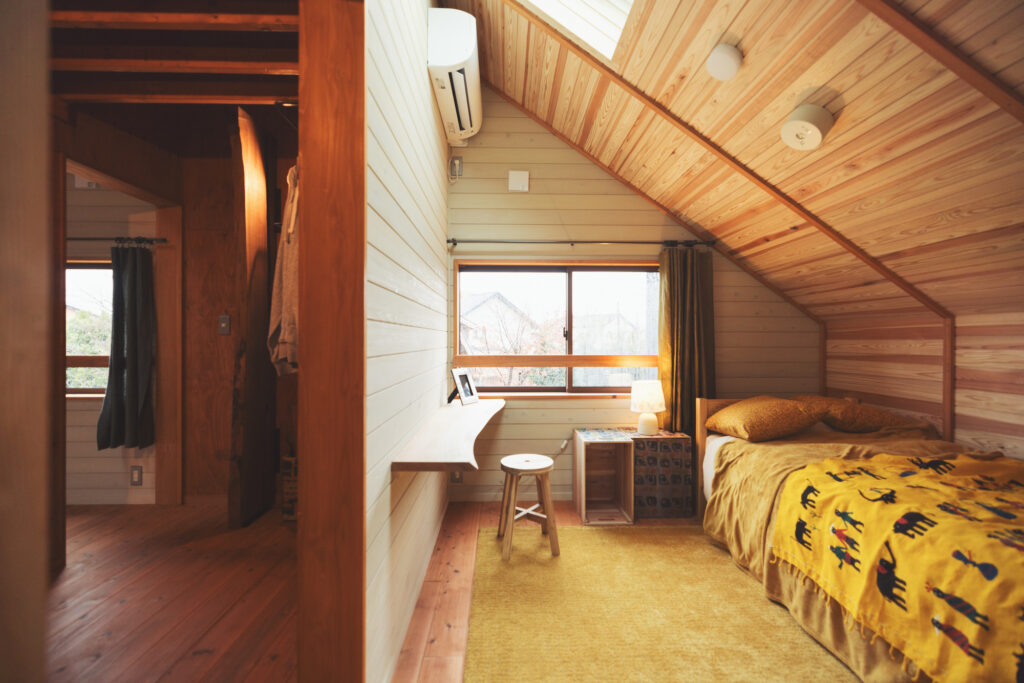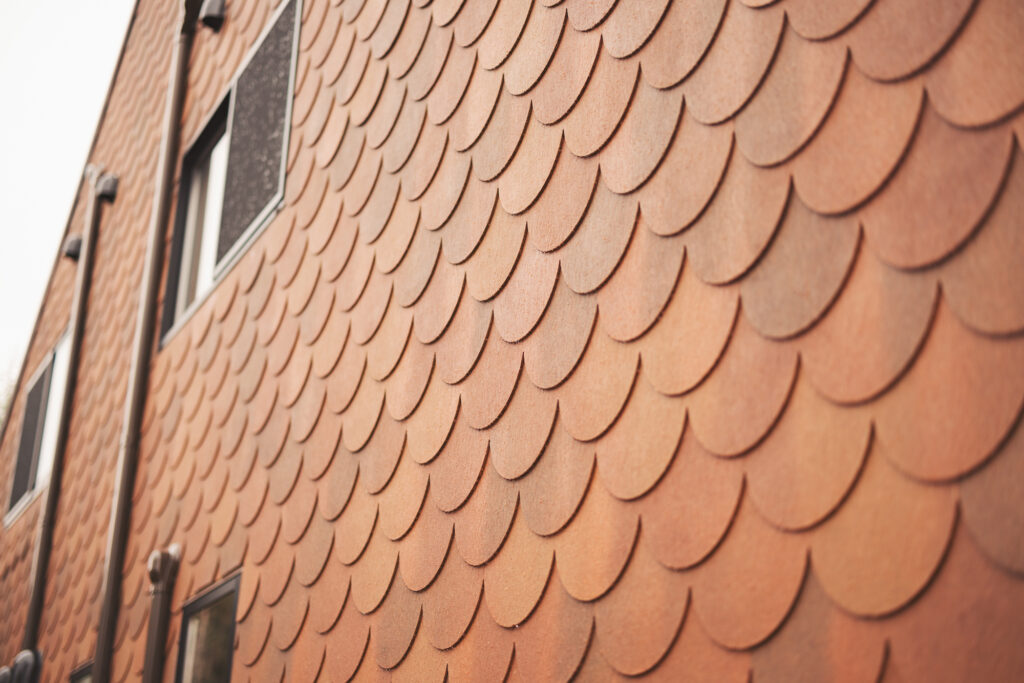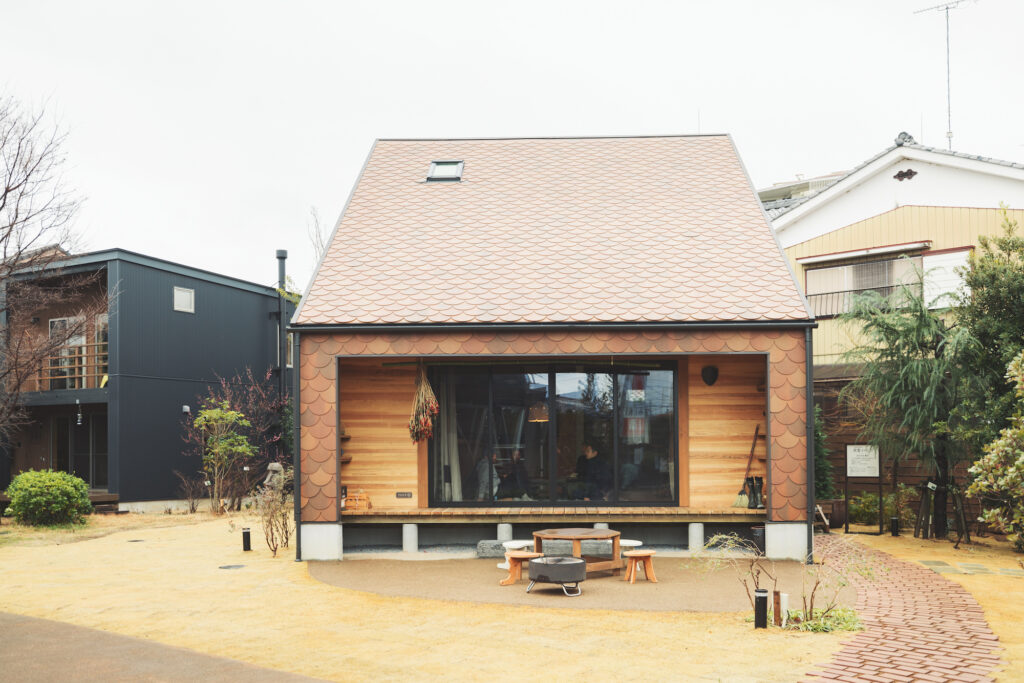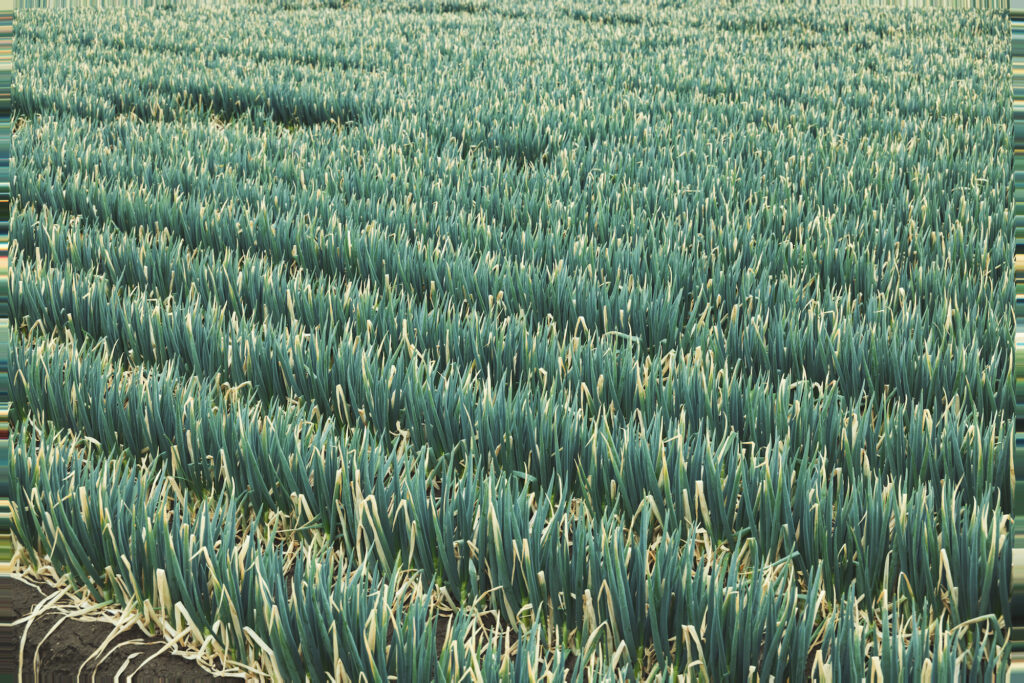
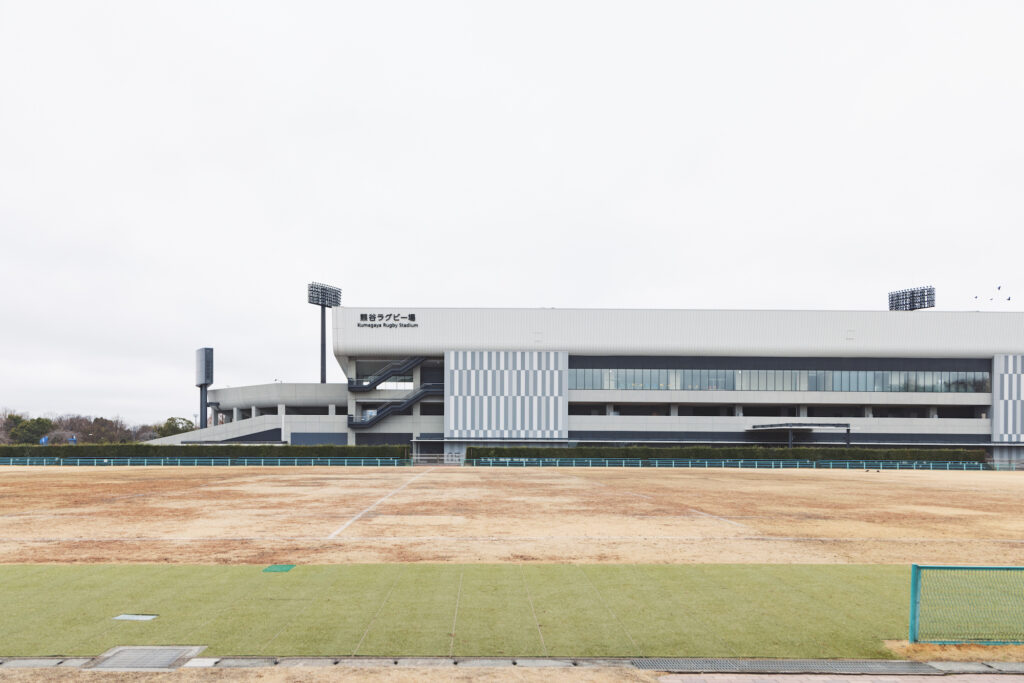
This installment is a special edition. We explored “living in comfort” fit for the future at BESS LOGWAY in Kumagaya City, Saitama Prefecture, focusing on a new house model, the “ma-nu-ke-no-hako,” which has just been built. In attendance were Lucas, the editor-in-chief of PAPERSKY; Yuichiro Yamanaka, a chief designer at BESS, who conceived the “ma-nu-ke-no hako”; Kensuke Yamamoto, sales division at BESS; and Akira Horiuchi, a PAPERSKY editor who moved to Hanno, Saitama, about two years ago. In the convivial living room of “Manu-ke-no-hako,” they shared the ideal lives they each aspire to (over snacks and tea, of course.)
Traveler/Lucas B.B.(PAPERSKY Editor)
Traveler/Akira Horiuchi(PAPERSKY Editor)
Host/Yuichiro Yamanaka(BESS Chief Designer)
Host/Kensuke Yamamoto(BESS Sales Division)

1. A bountiful story that begins with a keyword
In response to an internal challenge to come up with a new BESS model, designer Yamanaka suddenly came up with the keyword “ma-nu-ke” (“open plan”). Needless to say, not the word “ma-nu-ke” meaning “dumb”, but the one meaning “open plan”; but how did he come up with such an interesting keyword? This is where the conversation began. After taking a quick peek around the actual “ma-nuke-no hako” it was Lucas who kicked things off.
Lucas: ”I feel pretty excited, ha ha. “I thought this new model sounded interesting from the moment it was announced. The atmosphere of the house and the name are very upbeat and free, and I thought if I were going to have a BESS house built, this would be the one I would choose. It’s an exciting house.”
Yamanaka: ”I’ve been designing BESS houses from the planning stage for more than 2 decades. The first step is always to suggest what the BESS brand should do to the member of the development team. Based on the values that BESS has nurtured so far, we have to propose what kind of house we should release for the next era.”
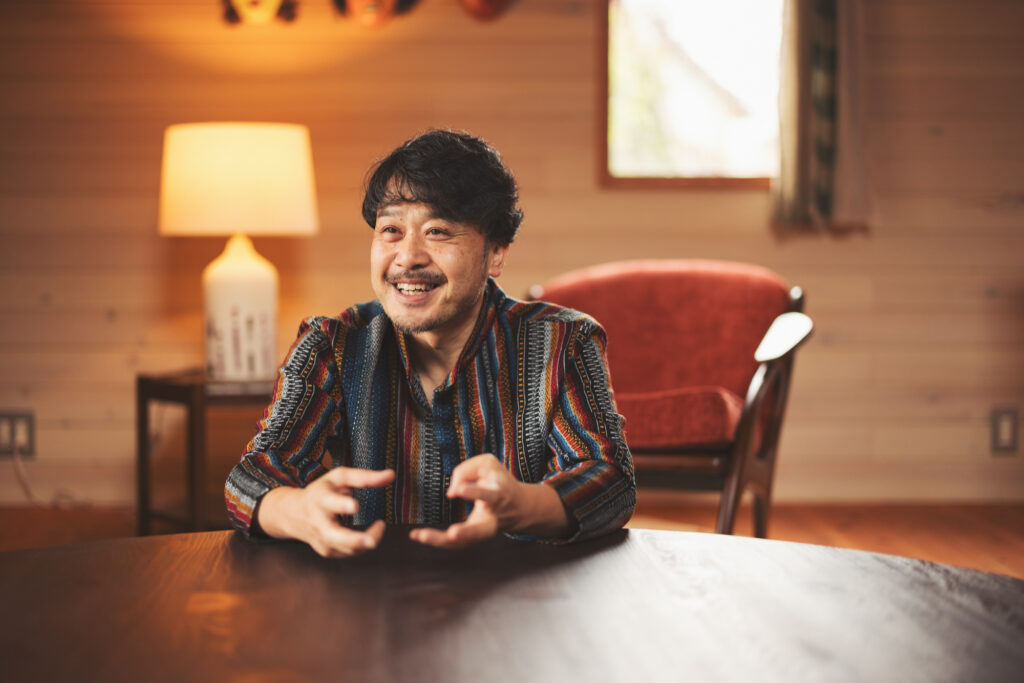
Lucas: ”What do you say first of all to participants in the meeting?”
Yamanaka: ”It is not about specific house forms or floor plans, but words. We put into words our sense of values about “living” that extends beyond the house and into the future.”
Lucas: ”And this is what “ma-nu-ke” refers to?”
Yamanaka: ”Exactly. Most home builders would never name a house “ma-nu-ke” (“halfwit”) Lol. But I felt this word has overtones of endearment. If you want to blame someone you call them “Baka” (“idiot”) but the word “ma-nu-ke” has a bit of gentleness and humor to it, and is a word of forgiveness, and also the word “nu-ke” (“open”) leaves a good amount of leeway. I also feel that in this age of AI evolution and compliance regulations, we are being expected to provide the correct answer in a wide variety of situations, and people are losing their leeway.”
Lucas: ”Totally agree.”
Yamanaka: ”The BESS brand has always embraced the value proposition of “easygoing living,” but I thought it was time to redefine “easygoing” in a new and different way. That’s when the words “ma” (“space”) and “nu-ke” (“open”) came to mind. The word and concept of “openness” has long been a part of Japanese aesthetics; the same is true of the word “ma,” but both conjure up the image of a pleasant feeling, or a well-defined gap in time and space. I thought I could create a concept based on these two words of “ma” and “nu-ke, and that is where “ma-nu-ke” came from.”
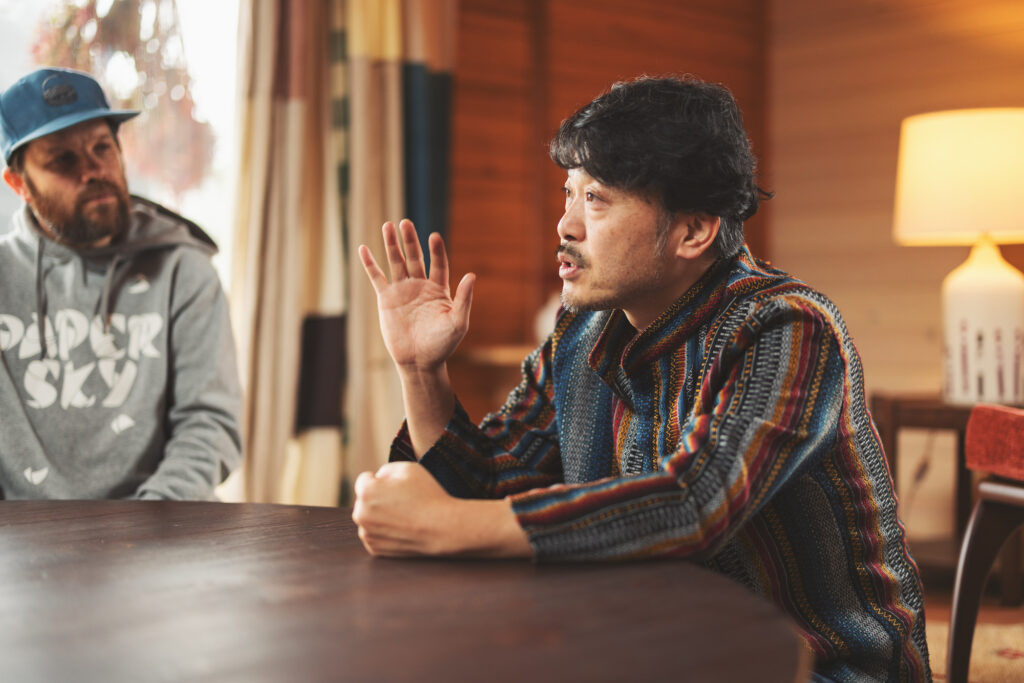
Lucas: ”Yamamoto-san, how was it for you in terms of the sales aspect?”
Yamamoto: ”Well actually I was a bit bamboozled when I first heard it, Lol. But when I sat down and thought about it, I realized that it was very much in tune with the current generation. In a society that demands speedy and correct answers to everything, I felt that somehow people were not satisfied in their hearts.The word “ma-nu-ke” has a soft and human touch right? Indeed, this house is very comfortable with its “open” space that makes you feel at home.”
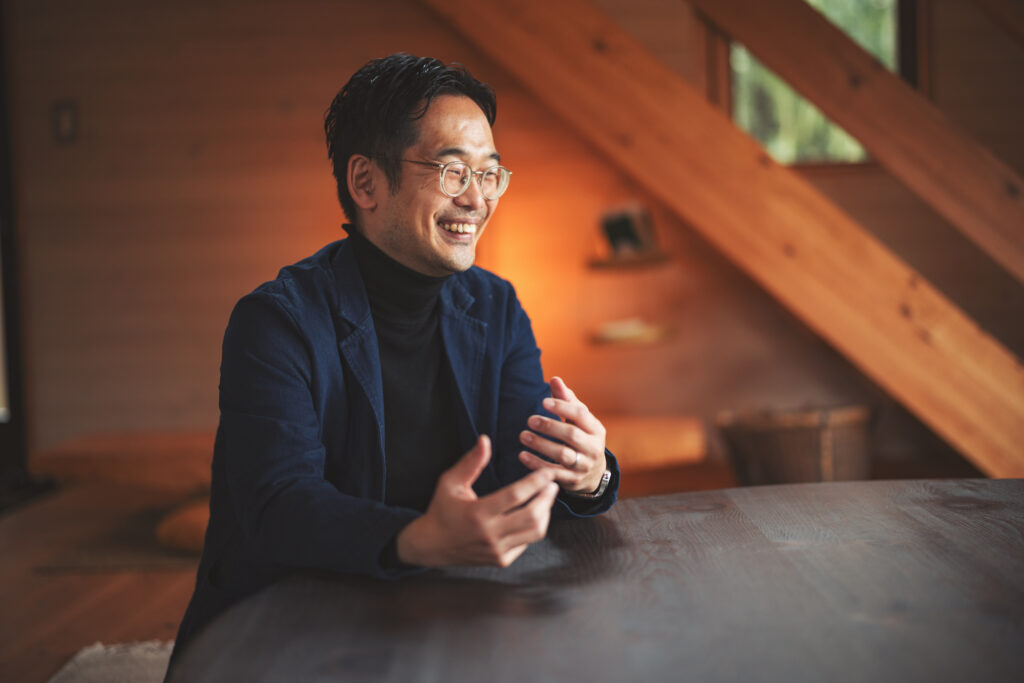
Yamanaka: ”BESS is a company that takes its words extremely seriously, and whenever we start to create something, we always try to share among team members the words that describe the concept. I think that once the words are in place, things will naturally follow from there.”
Lucas: ”It makes perfect sense. Once you have settled on the words, the visuals can fall into place. It’s like the necessary elements naturally come together in response to a certain word, or perhaps a certain ambience is created.”
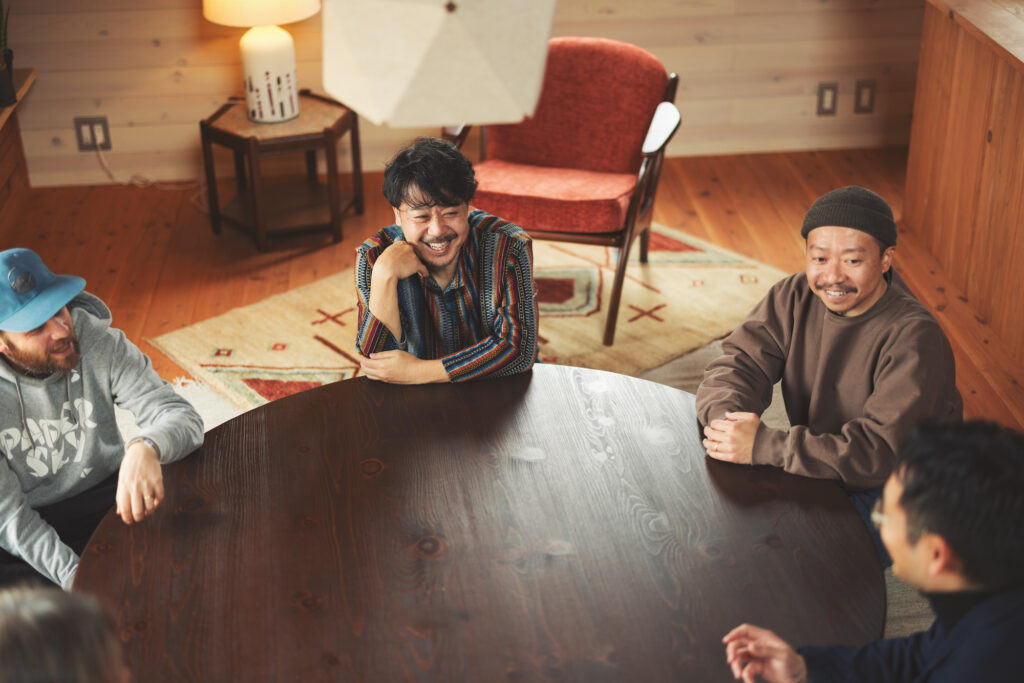
2. Focusing on the traditional Japanese aesthetic value of the “engawa” (veranda/external corridor )
Horiuchi, who regularly visits various regions for content creation, moved from central Tokyo to Hanno City, Saitama, about two years ago to make his daily search for new ideas more colorful.He has also just secured an ideal plot of land surrounded by nature and built a house with natural wood texture. Horiuchi shared his impressions upon seeing “ma-nu-ke-no hako” for the first time.
Horiuchi: ”I can’t help but feel that this “ma-nu-ke-no hako” is packed with everything I was looking for in a house. I wanted to make use of woody textures as much as possible, inject a sense of “Japanese” flavor, and have almost no partitions, or walls, in the house. I had an image of BESS as being natural and progressive, but this “ma-nu-ke-no hako” has the feel of a home that Japanese people have lived in from eons ago. It feels like the kind of atmosphere that Japanese people would feel at home in.”
Lucas: ”I know, it totally feels like a Japanese home. I particularly like the engawa.“
Horiuchi: ”The open engawa (veranda) out front is so refreshing. There are no boundaries on it, and it gives a sense of natural connection between the outside and the inside, wouldn’t you say?”
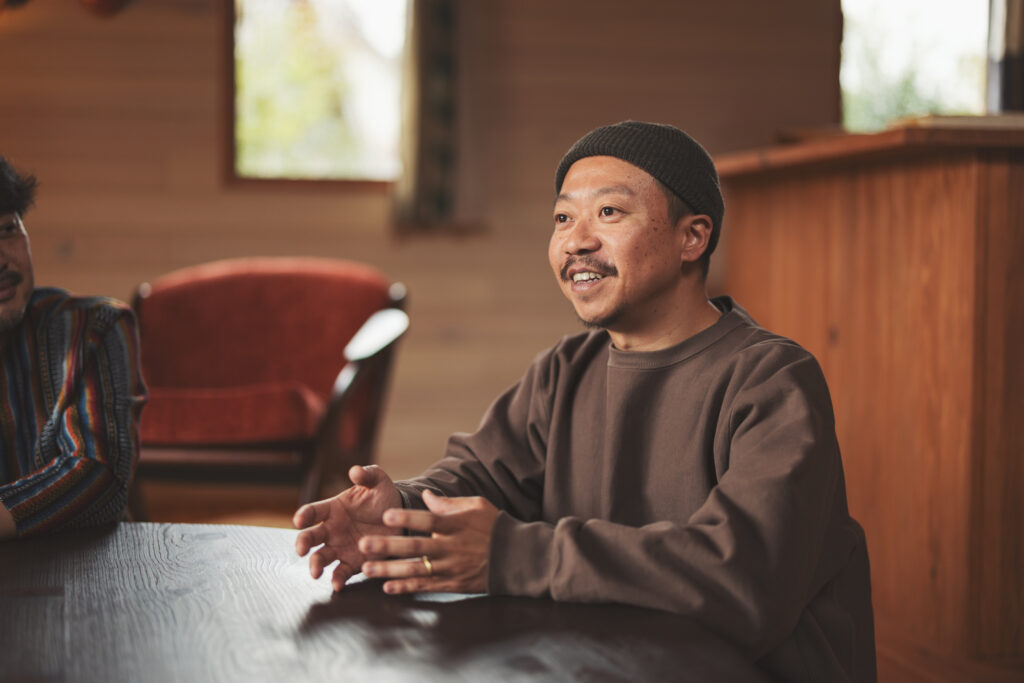
Lucas: ”If I got this house, I would want to enter and exit from the engawa; I probably wouldn’t even bother with an entrance or front door , ha ha !”
Yamanaka: ”I’m so glad you think so. The entrance and door aside (ha ha.) The engawa was a focal point, asI think Japanese houses have created more and more boundaries as they have become modernized. The idea seems to be to first close off communication from the outside by building a gate at the entrance to the site, erecting a fence on the boundary with the neighboring house, and installing a security camera. Naturally, it is better to prevent unwelcome intruders, but if we are not careful, we are heading for a breakdown in communication. I imagine that the good old Japanese life was a little rosier and warmer. That is precisely why we wanted to revisit the idea of connecting the inside of the house to the outside, and the town to the house.”
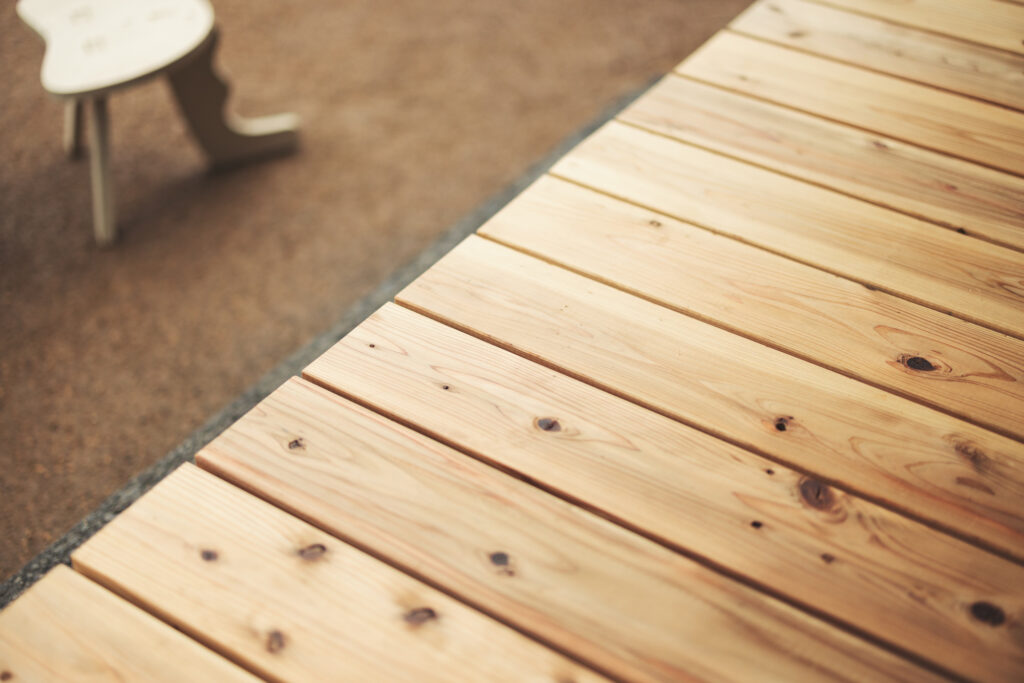
Horiuchi: ”When I started living in the suburbs, neighbors would bring me vegetables, and people would drop by at random times. On such occasions, the engawa is just right. We can sit and shoot the breeze without overthinking it.”
Lucas: ”You can’t beat a cup of tea and a chat on the engawa with somebody can you.”
Yamanaka: ”We wanted to make the “ma-nu-ke-no hako” look welcoming from the outside. That’s why I made the entire surface a veranda (laughs). It beckons people to come on over.”
Lucas: ”From the outside, it’s easier to strike up conversation if people are sat on the veranda.”
Yamanaka: “It was very much our intention that having no doors or partitions in the house would allow people to connect more easily”.
Horiuchi: ”I wanted to have as few partitions as possible in my own house. Even though we are in different places, there is a sense that the family is connected. This “ma-nu-ke-no hako” really is as open plan as you can get, isn’t it.”
Lucas: ”I’m absolutely fine with having no partitions in the house. In fact, it makes it more fun to think about how to use all that open space.”
Yamamoto: ”That’s right. Of course you can customize the house if you need private spaces, and BESS is all about providing people the freedom to live in the house in the way that they want.”
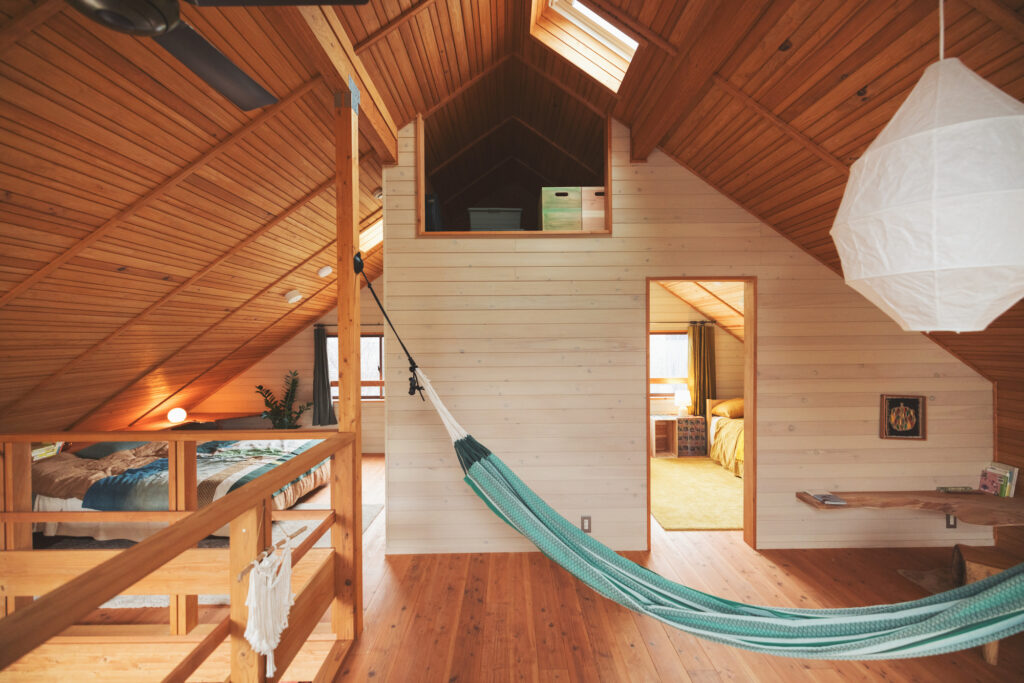
Lucas: ”At the moment I divide my time between Shibuya and Yaizu in Shizuoka – we share the house with a 92-year old lady in Yaizu and it’s interesting to see how she moves around; when it’s nice and sunny, she stays in the sunniest part of the house, and when it’s a little cold, she gravitates to the warmest part of the house.”
Horiuchi: ”Sounds like a cat, Lol.”
Lucas: ”Exactly. But it’s natural to do so, no? No need to be tied to the living room or bedroom. You should just go to the space that feels best at that particular moment.”
Horiuchi: ”There are often preconceived notions, aren’t there? I believe that once these concepts are discarded, new possibilities for daily life will emerge.”
Lucas: ”Couldn’t agree more. Anyone else feeling peckish by the way?”
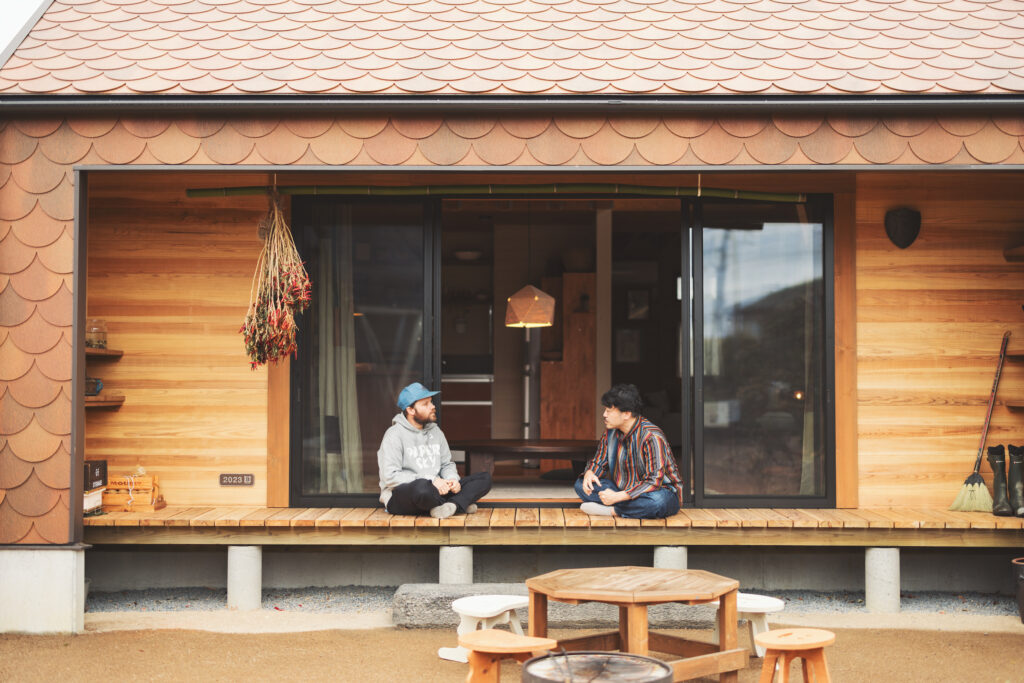
3. The need for a “middle ground.”
At this point, Horiuchi brought out some snacks. Out of the box came a cute-looking snack that looked like an egg. To be precise, “Egg Baum,” from a baumkuchen specialty store directly operated by a poultry farm in the town of Muroyama, Saitama Prefecture. While munching on soft and fluffy egg-shaped baumkuchen, the conversation turned to the somewhat difficult concept of “the middle ground.” And what exactly is it?

Lucas: ”Mmm, delicious.”
Horiuchi: ”Snack time gets a whole lot better when you’ve got an engawa.“
Lucas: ”Yes, it’s true. When you have the space, you can get a little creative in your living.”
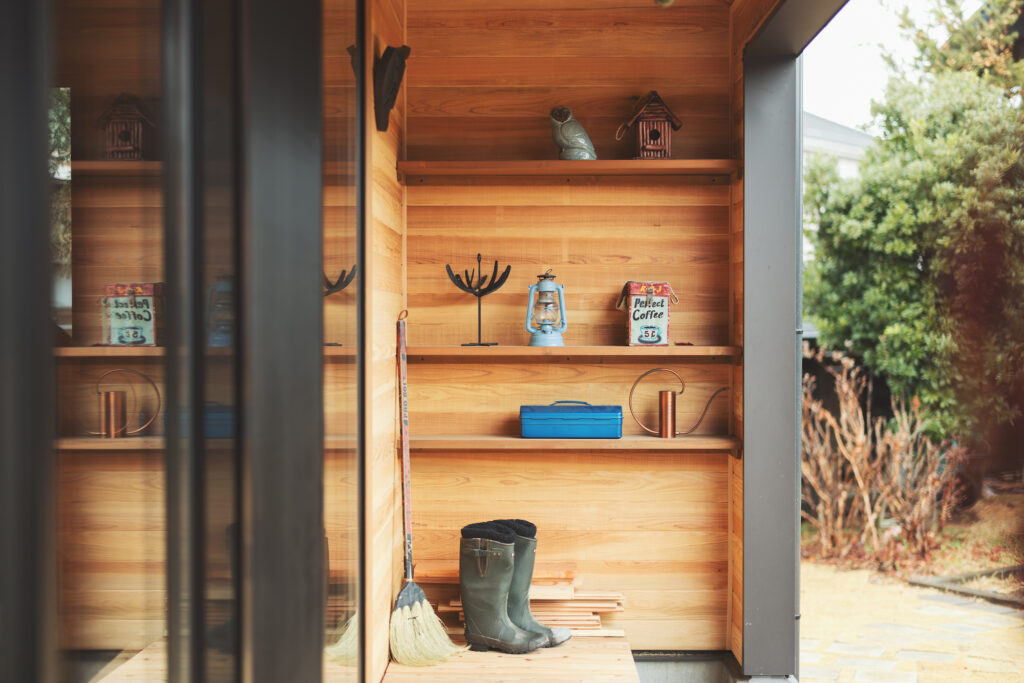
Yamanaka: ”Come to think of it, I’m part of a study group called “under the eaves research circle.”
Lucas: ”And what is that all about?”
Yamanaka: ”Japanese houses are gradually losing the space under the eaves, so this is a meeting to reaffirm its value. BESS is also working hard to preserve this important space.”
Lucas: ”I personally love that space under the eaves.”
Yamanaka: ”Me too. The reason for the loss of eaves is clear: building codes.You can have eaves up to 1m from the wall, but if you go beyond that, it would be calculated into the floor area. In other words, if the eaves are to be extended more than 1 m, the floor area must be narrower on a limited site. Therefore, many people try to keep the eaves minimal and the floor space as large as possible. However, if the eaves are less than 1 m, there is no way to effectively use the space under the eaves.”
Horiuchi: ”So that’s what this is about…”
Yamanaka: ”When you prioritize floor space, the area under the eaves, the middle ground between the outside and the inside, is squeezed out. Then you end up cooped up in the house, relying on the air conditioner.”
Lucas: ”‘ma-nu-ke-no hako’ has plentiful eaves doesn’t it.”
Yamamoto: ”Yes, to the fullest.”
Yamanaka: ”We wanted to keep middle space between the outside and the inside, so we secured as much space under the eaves as possible.”
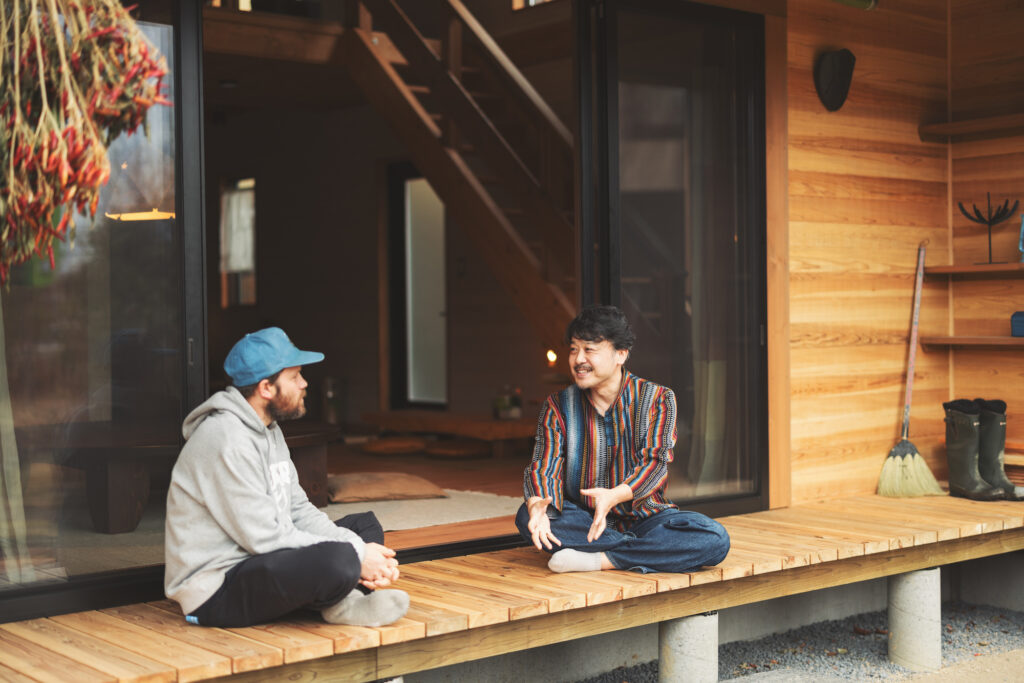
Lucas: ”Saitama is kind of in between Tokyo and the countryside, isn’t it?”
Horiuchi: ”Exactly. I think I chose Saitama because it was “in the middle”. I have to step out to Tokyo for work a few days a week, but gradually, I started to seek a tranquil environment enclosed by nature. I feel that if I am in the middle area, I can get the best of both worlds. Plus, I feel that having a middle ground in my home is very calming.”
Lucas: ”When you are in the city, you always feel like you have to be doing something. But there’s a lot to be said for just idling. Sometimes good ideas come to me when I’m in a daze.”
Yamanaka: ”I think the Japanese of old understood the value of such ambiguity and gray areas deep in their hearts. With “ma-nu-ke-no-hako,” we sought to embody the comfort of the traditional Japanese house in a modern form.”
Lucas: ”I’m all in favor of entering or leaving the house through the engawa. No need for a door or an entrance, ha ha !”
Yamamoto: ”Yes, we hope to meet the needs of various customers, but I’ll go back to the headquarters and see if we can eliminate the front door!”
